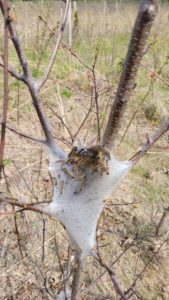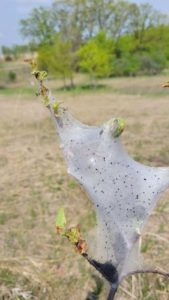Have you ever seen webs in the branches of trees and thought, “wow, that’s a thick spider web!” It wasn’t actually a spider web, it was a forest tent caterpillar’s home. While these pests aren’t harmful to humans, they can be destructive to trees.
Table of Contents
- Forest Tent Caterpillar
- Life Cycle
- Destruction of Trees
- Other Hazards Forest Tent Caterpillars Cause
- 4 Ways You Can Treat Forest Tent Caterpillars
- How We Treat Forest Tent Caterpillars
- Conclusion & Next Steps
Forest Tent Caterpillar

These little caterpillars are found all throughout North America wherever hardwood trees are. Fully grown caterpillars are up to 2 inches long, blue and black, but can be tan and brown as well. They have spots down their back and are furry along the sides of their body.
Forest tent caterpillars can destroy trees, once trees are defoliated they can destroy plants. They have even been known to damage fruit and vegetable crops.
They turn into tan, fuzzy moths that you’ve seen. These moths are nocturnal and are attracted to light.
Did you know these caterpillars are so group oriented that they forage together. Either they all eat or no one eats.
Life Cycle
Forest tent caterpillars hatch and start to feed mid-May, about the time Aspen trees are in bloom.
These caterpillars make these silky homes to keep warm in the early spring when temperatures dip down below freezing, and feed for about 6 weeks before spinning a cocoon. By the end of June is when they are fully grown and ready to find a secluded spot to spin their cocoon.
Two to 3 weeks after spinning its cocoon, the adult moth emerges from its cocoon.
While the adult moths only live about 5 days, they lay anywhere between 100 and 350 eggs in that time!
Males emerge before females do. Males begin the search of a female cocoon, which they can find by a pheromone the female emits. The males wait for the females to emerge from the cocoon. When the female starts to emerge bottom first, the males mate prior to the full emergence of the female.
Fun fact: the copulation between males and females takes 3.5 hours where the female moth is half in half out of the cocoon.
They lay their eggs in little gray, cylindrical patterns around tree branches. It kind of looks like a brillo pad called spumaline. The silky material of these egg cases protects the eggs over the winter until they can hatch the following spring.
Because of the large number of eggs, it only takes one batch to devastate a small tree. The hatched caterpillars remain in groups for their life before cocooning.
Destruction of Trees
These caterpillars eat tree leaves. That kills the tree? Not all at once, no. Trees can regrow leaves in the same season it loses them to these caterpillars. But if the tree’s leaves are removed constantly and the tree has to regrow the leaves and not focus on its growth, it may die.
If these leaf-eating pests eat all of the leaves a couple of years in a row, the tree may die.
If the weather is very dry or areas are in a drought and these trees don’t have enough water to replace the eaten leaves, the tree may die.
Though the trees may not die, or it may take years for it to die, the loss of growth can be great (up to 70% loss of growth).

Other Hazards Forest Tent Caterpillars Cause
Though forest tent caterpillars try to make their home in crooks of trees, they will occasionally make their homes on the sides of buildings or elsewhere.
If they do make their homes on sides of buildings, the silky material is hard to remove. This creates a nuisance for the homeowner or property manager.
If a silky nest is ever made onto streets, it creates a hazard. These nests are slippery and when driven over, they can be as dangerous as a patch of ice, maybe more so because the driver isn’t expecting slippery conditions in warmer temperatures.
4 Ways You Can Treat Forest Tent Caterpillars
- If you see one of these silk nests beginning to be formed, remove it. Actively look for those brillo-pad-looking egg sacks around tree branches and remove and kill those eggs.
- You can use a stiff broom to brush remove the nests, as the strong fibers of the broom will tear through the silk nest.
- If you see any of these nests on sidings of houses or other belongings, be careful as you remove them. Any caterpillars left on the inside may smear into your paint and discolor it.
- You can also find a type of insecticidal soap that will conserve beneficial insects but rid you of these nuisance pests.
How We Treat Forest Tent Caterpillars
Done Right Pest Solutions employs a chemical product that we can treat trees proactively with, or reactively. The product we use will kill any caterpillars on contact within a few minutes. It also has a lasting residual product to prevent any newly hatching caterpillars from creating a silky home in the branches.
The service will come with a 2 month warranty. Our technicians will remove as many silky nests as possible.
This service is included in our Peak Seasons Plan, so if you own a home in the 7-metro county area Minnesota or western Wisconsin, give Done Right Pest Solutions a call for a free estimate. You can read more about all of our services offered to residential clients on our Residential Pest Control.
For other yard pests, check out this category within our blog.
Conclusion & Next Steps
Today you learned about forest tent caterpillars, their life cycle, and how destructive their habits can be on trees. You learned 4 ways you can treat forest tent caterpillars and how we treat these pests.
If you have these destructive pests that leave silky nests in your yard, try removing them and proactively removing the egg sacs. Try treating with a soap-based insecticide.
If these methods don’t work or you can’t treat high enough in the trees, give Done Right Pest Solutions a call. We would love to take care of these pests for you. You also get peace of mind knowing within the 2 month warranty if you see any rebuilding of those silky webs, give us a call. We will come back out at NO charge.
We look forward to solving this pest issue for you.
Done Right Team
Have you ever seen these silk nests in trees? They are unique, but destructive pests. Tell us of your experience with these pests below!
Want to learn more about different pests? Or maybe about services and promotions we offer? Sign up for our newsletter!

